#programmatic design
Explore tagged Tumblr posts
Text
Today, I decided to get a few things together, and tested out working with my tablet* by picking up a copy of Grünberger’s “Analog Algorithm” we have lying around in Mannheim and, well, working with it (you can see the work in progress on my Instagram here: https://www.instagram.com/p/C8KhRwxCn0J/
After a few issues with storing and naming the files I worked with (and I am still pretty sure that I didn’t get the permutations right), I posted the screenshots to my Instagram account, while remembering that this was not the first time I worked with this particular book.
Switching back to my laptop, I looked for the files from last time, and especially from when they they were.
Boy, was I surprised to see their date: 22nd of June, 2022. Two years ago, bachelor’s thesis between those files and now, if I may. I am consistent in my summer endeavours.
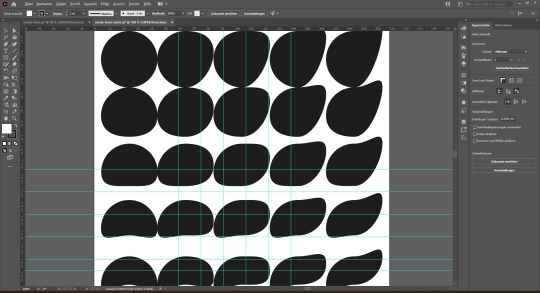
And I had this smile on my face. How awesome is that? You just continue from where you left off. No deletion, no destruction, just a continuation of your own process, at your own pace.
As part of my explorative investigations into design as program(me), I’m also investing time into Karl Gerstner’s “Designing Programmes”, as well as an aside and, for later, Christian Büning’s “Zirkeltraining für die Augen”, a book which will hopefully allow me to improve my visual design acuity at first glance, which I value as very important for an art director.
Link list of the books mentioned:
Get “Analog Algorithm” from slanted, Lars Müller Publishing, or from Amazon Read more about Analog Algorithm on its dedicated website, https://analog-algorithm.com/
Get the “Designing Programmes” 1967 edition from archive.org, Amazon, and from Lars Müller Publishing There is also a new reprint of this book, which you can find here, https://haraldgeisler.com/books/ in English, German, and French, bien sûr!
Get “Zirkeltraining für die Augen” from Werkstoff Verlag, or from Amazon.
Link list of the people mentioned
Christoph Grünberger’s Linktree
Karl Gerstner’s estate Website
Christian Büning’s studio Website
*Adobe Illustrator is sluggish on my tablet, while making me angry with how file storage works for these poor ports of the excellent desktop app
#analog algorithm#graphic design#parametric design#programmatic design#christoph grünberger#karl gerstner#christian büning#code & canvas#after-hours blogging#after-hours#graphic design books#adobe illustrator
3 notes
·
View notes
Text

Dale's Donuts, Compton, California, Photograph: Nathan Marsak
#programmatic architecture#architecture#design#art#architecture parlante#dale's donuts#Compton#LA#California#Nathan Marsak#photography#donut#donuts
359 notes
·
View notes
Text
How AI Is Taking the Guesswork Out of Creative Advertising

In a world where attention is the most valuable currency, marketing can no longer rely on trial-and-error. Today, every second, swipe, and scroll matters. Brands are expected to deliver precision-targeted content that resonates instantly. The days of guesswork in advertising are fading fast—thanks to Artificial Intelligence.
At Apppl Combine, we’re not just keeping pace with this transformation—we’re shaping it. As a forward-thinking AI creative agency, we believe that creativity, when powered by AI, becomes not just more efficient but also more insightful, data-driven, and truly scalable.
Let’s dive into how AI is removing the ambiguity from creative advertising, and why Apppl Combine is the partner you need to lead in this new era.
The Traditional Creative Process: Inspired, But Inconsistent
Creative advertising has always thrived on intuition, emotion, and originality. And while these qualities remain vital, they often come with an inherent challenge—subjectivity.
Will the audience like this headline?
Is this the right color scheme for Gen Z?
Which version of the ad will perform best?
Without solid data, marketers have long been making educated guesses. And while A/B testing and consumer research helped, they were time-consuming and expensive. Enter AI, where art meets science.
How AI Is Changing the Game
AI has the power to take the guesswork out of each stage of the creative advertising pipeline. At Apppl Combine, we use AI not just as a tool—but as a creative collaborator.
Here’s how we do it:
Audience Insights, Supercharged
Understanding your audience is the foundation of any strong campaign. With AI, we tap into behavioral data, psychographic profiles, and predictive analytics to gain deeper, real-time insights into your audience.
Instead of designing for a "target demographic," we create content tailored for real individuals—at scale.
Example: We used AI-driven social listening and sentiment analysis to uncover micro-trends and customer frustrations. That insight directly influenced ad copy and visuals, resulting in a 30% higher click-through rate.
AI-Powered Copywriting That Converts
AI isn’t just about numbers—it’s also becoming a wordsmith. At Apppl Combine, our content teams use AI writing assistants to generate copy variations, refine tone, and even optimize messaging for different platforms and personas.
This allows us to:
Rapidly test different headlines and CTAs
Adjust tone for emotional resonance
A/B test thousands of combinations at lightning speed
No more guessing what copy might work. AI gives us the data-backed versions that will work.
Visual Storytelling with AI Design
From layout generation to dynamic imagery, AI is revolutionizing how visuals are created. We use AI tools to:
Create auto-generated ad creatives with brand-consistent themes
Generate multiple versions for different audience segments
Test visual appeal using predictive heatmaps
This isn’t creativity by robots—it’s creativity enhanced by machine precision.
AI in Ad Film Production
As a full-service AI creative agency, we’ve brought AI into our video and ad film production pipeline as well:
Script Generation: AI helps brainstorm angles, tones, and concepts.
Voice Synthesis: Localized voiceovers in multiple languages.
Smart Editing: AI-assisted editing tools help automate transitions, syncs, and captions.
Post-Production Optimization: Predictive tools help us know what parts of a video are likely to hold attention—or lose it.
The result? Faster, smarter, and more adaptable ad films that perform.
Real-Time Optimization
We don’t just launch campaigns and hope for the best. With AI, we track performance data in real time and optimize creatives on the fly.
What used to take weeks of waiting and analysis, we now do in hours.
That means:
Swapping underperforming visuals mid-campaign
Personalizing content dynamically based on user interaction
Increasing ROI with data-informed creative changes
Why Choose Apppl Combine as Your AI Creative Partner?
We’re not your average creative agency tinkering with AI tools on the side. At Apppl Combine, AI is at the heart of how we think, create, and deliver.
✅ We Combine Strategy, Story, and Science
Our roots are in strategy and storytelling. We understand brand voice, emotional narrative, and cultural context. But now, we pair that with AI to ensure that every piece of creative isn’t just beautiful—it’s intelligent, purposeful, and performance-oriented.
✅ Proven Track Record in AI Creative Campaigns
From high-converting video ads to multilingual AI-enhanced explainer videos and data-personalized ad films, we’ve delivered measurable success for brands across industries. We’ve helped brands:
Reduce creative turnaround time by 60%
Improve ad engagement by 30–50%
Generate 4–5x the creative variants without 4–5x the budget
✅ Scalable Solutions for Fast-Growing Brands
Startups and enterprises alike need creative agility. With our AI-powered pipeline, we can produce high-quality creative assets at scale—without losing the soul of the brand.
The Bottom Line: AI Is the Future of Advertising. But the Right Agency Makes It Work.
Artificial Intelligence is no longer a novelty in advertising—it's the new normal. But technology alone isn’t enough. You need a creative partner who knows how to use it strategically, intuitively, and effectively.
At Apppl Combine, we blend the best of both worlds: the unmatchable power of AI with the irreplaceable art of human storytelling.
No more guesswork. Just creativity that works.
Ready to future-proof your advertising?
Partner with Apppl Combine, your trusted AI creative agency, and let's build campaigns that are smarter, faster, and built for impact.
Connect with us: www.apppl.com
This post was originally published on: Apppl Combine
#AI in advertising#AI creative agency#data-driven marketing#AI marketing tools#AI-powered campaigns#creative automation#personalized advertising#Apppl Combine#AI in branding#programmatic creativity#AI copywriting#AI design tools#advertising technology#creative optimization
0 notes
Text
Want to Elevate Your Business Online? If yes, Elevatedigi is one of the leading full-stack digital marketing company that have expertise in SEO, SMM, creative design, web development. So if you want to make online presence for your business, ElevateDigi is the right place.
0 notes
Text
The Power of Programmatic SEO for Higher Rankings
Search engine optimization (SEO) has become a fundamental strategy for businesses aiming to enhance their online visibility. Among the many approaches, programmatic SEO is emerging as a game-changer. This article delves deep into the concept of programmatic SEO, its benefits, its relevance to Dubai SEO, and its connection to Dubai website design. By the end, you’ll understand how this advanced approach can revolutionize your digital presence.
What is Programmatic SEO?

For instance, if a travel website wants to rank for “Best hotels in Dubai,” programmatic SEO can generate hundreds of pages tailored for different types of searches, such as “Best budget hotels in Dubai” or “Luxury hotels near Dubai Marina.” Each page is crafted with relevant content and keywords to target specific user needs.
Programmatic SEO is especially effective for businesses targeting a broad audience with diverse search intents. By leveraging tools, data, and templates, businesses can quickly create a significant online footprint.
How Does Programmatic SEO Work?
Programmatic SEO works by using automation and templates to create unique and relevant pages at scale. Here’s a step-by-step explanation:
Keyword Research: Identify a wide range of keywords and phrases that users search for.
Structured Data Collection: Gather information relevant to the keywords, such as location-specific data or product details.
Template Creation: Design templates for web pages with placeholders for dynamic data.
Automation Tools: Use tools to populate the templates with structured data to create multiple pages automatically.
Optimization: Ensure each page is optimized with meta tags, headings, and internal links.
Monitoring and Updating: Analyze performance and update pages as needed to improve rankings.
This process helps create hundreds or even thousands of pages in a fraction of the time it would take using traditional methods.
Why is Programmatic SEO Important?
Programmatic SEO is important because it addresses the growing need for businesses to scale their content strategies. Here are some reasons why it matters:
Scalability: It allows businesses to create a large volume of content quickly and efficiently.
Better User Targeting: By addressing specific user queries, it improves user experience and engagement.
Cost-Effective: Reduces the time and resources needed for content creation and optimization.
Enhanced Local SEO: Businesses can target localized queries, such as “SEO company in Dubai” or “Dubai website design.”
Competitive Edge: Staying ahead in competitive markets like Dubai SEO requires innovative strategies, and programmatic SEO delivers that.
For businesses operating in Dubai, leveraging programmatic SEO can help capture the attention of a diverse audience searching for products or services in the region.
Benefits of Programmatic SEO
The benefits of programmatic SEO are numerous and impactful. Here’s a closer look:
Increased Visibility: By creating pages for a wide range of keywords, businesses can dominate search engine results.
Improved Efficiency: Automation reduces manual effort, allowing teams to focus on strategy and creativity.
Better Analytics: With more pages, businesses gain insights into user behavior and preferences.
Local SEO Dominance: For companies targeting local markets, such as an SEO company in Dubai, programmatic SEO enables them to rank for location-specific queries.
High ROI: The scalable nature of programmatic SEO ensures a higher return on investment compared to traditional methods.
By integrating programmatic SEO into their strategies, businesses can achieve sustainable growth and stay ahead in the digital world.
What is Programmatic SEO in Web Design?
Programmatic SEO and web design are closely interconnected. In web design, programmatic SEO influences the structure and functionality of a website. Here’s how:
Template Design: Websites must be designed with templates that accommodate dynamic content.
Navigation: Proper navigation ensures that users and search engines can easily access all pages.
Mobile Optimization: Since many users search on mobile devices, web design must prioritize responsiveness.
Load Speed: Programmatically created pages must load quickly to enhance user experience.
For businesses focusing on Dubai website design, integrating programmatic SEO ensures the site is not only visually appealing but also optimized for search engines.
The Future of Programmatic SEO
The future of programmatic SEO is promising as technology continues to evolve. Here are some trends to watch:
AI Integration: Artificial intelligence will play a significant role in analyzing data and creating content.
Voice Search Optimization: With the rise of voice assistants, programmatic SEO will adapt to conversational queries.
Enhanced Personalization: Pages will become even more tailored to individual user preferences.
Global Reach: Businesses can expand their reach internationally while maintaining local relevance.
For companies involved in Dubai SEO and Dubai website design, staying updated with these trends will be crucial to maintaining a competitive edge.
Key Tools for Programmatic SEO
To implement programmatic SEO effectively, several tools are available. Here are some of the most popular ones:
SEMrush: For keyword research and competitive analysis.
Google Data Studio: To visualize and analyze data.
Ahrefs: For backlink analysis and content gap identification.
Python: For automation and scripting.
WordPress: To create and manage dynamic pages using plugins.
Using these tools, businesses can streamline their programmatic SEO strategies and achieve better results.
How Web Design Companies Benefit from Programmatic SEO
Web design companies play a pivotal role in implementing programmatic SEO. Here’s how they benefit:
Enhanced Client Services: By offering programmatic SEO, web design companies can provide comprehensive solutions to clients.
Increased Revenue: Additional services lead to more revenue streams.
Stronger Portfolios: Successful implementation of programmatic SEO showcases their expertise.
Improved Collaboration: Working closely with SEO experts enhances their offerings.
For companies in Dubai website design, incorporating programmatic SEO can attract more clients seeking cutting-edge solutions.
Final Words
Programmatic SEO represents a powerful approach to achieving higher search engine rankings. By understanding its workings, benefits, and integration with web design, businesses can unlock new opportunities. Whether you’re an SEO company in Dubai, a business owner, or a web design professional, embracing programmatic SEO can set you apart in the competitive digital world. With the right tools and strategies, the possibilities are endless.
#Programmatic SEO#seo#seo companies#seo agency#seo services#digital marketing#website design#website#dubai website design#web development#marketing#seo marketing
0 notes
Text
Elevate Your Online Presence with Fitch Technologies LLC: Expert Solutions for Website Development, Web Design, and Programmatic Advertising in Dubai
In today's digital age, having a strong online presence is imperative for businesses to thrive. Whether you're a startup or a well-established enterprise in Dubai, Fitch Technologies LLC offers comprehensive solutions to enhance your digital footprint. From website development and web design to programmatic advertising and marketing, we are your trusted partner in navigating the dynamic landscape of the digital world.
Website Development Cost in Dubai: Tailored Solutions for Your Business Needs
Your website is often the first point of contact for potential customers, making it essential to make a lasting impression. At Fitch Technologies LLC, we understand the significance of a well-designed and functional website in driving business growth. Our team of experienced developers specializes in creating custom websites that not only reflect your brand identity but also deliver an exceptional user experience.
When it comes to website development cost in Dubai, we believe in transparency and value for money. We offer competitive pricing packages that are tailored to suit your specific business requirements and budget constraints. Whether you need a simple informational website or a complex e-commerce platform, we have the expertise to bring your vision to life without breaking the bank.
Programmatic Advertising Dubai: Maximizing Your Reach and ROI
In today's fast-paced digital landscape, traditional advertising methods alone are no longer sufficient to reach your target audience. Programmatic advertising offers a data-driven approach to reaching the right people, at the right time, and in the right context. At Fitch Technologies LLC, we leverage the power of programmatic advertising to help you maximize your reach and return on investment.
Our team of digital marketing experts specializes in creating highly targeted and personalized campaigns that drive results. From display and video ads to social media and mobile advertising, we utilize cutting-edge technology and real-time data insights to optimize your ad spend and ensure maximum impact.
Web Design Dubai Price: Affordable Solutions for Stunning Websites
Your website's design plays a crucial role in capturing the attention of your audience and encouraging engagement. At Fitch Technologies LLC, we combine creativity with functionality to deliver web design solutions that stand out from the crowd. Whether you're looking for a sleek and modern design or a more traditional and elegant look, we have the skills and expertise to bring your vision to life.
When it comes to web design Dubai price, we believe in offering affordable solutions without compromising on quality. Our pricing packages are transparent and tailored to suit businesses of all sizes and industries. From responsive design and intuitive navigation to compelling visuals and engaging content, we ensure that every aspect of your website is optimized for success.
Programmatic Marketing Dubai: Driving Business Growth Through Data-Driven Strategies
In today's hyper-competitive market, effective marketing strategies are essential for business growth and success. Programmatic marketing offers a data-driven approach to reaching your target audience with precision and efficiency. At Fitch Technologies LLC, we specialize in creating customized programmatic marketing campaigns that drive results and deliver measurable ROI.
Our team of digital marketing experts utilizes advanced analytics and machine learning algorithms to identify and target the most valuable audiences for your business. Whether you're looking to increase brand awareness, generate leads, or drive sales, we have the expertise to design and execute campaigns that align with your goals and objectives.
Website Agency Dubai: Your Trusted Partner in Digital Transformation
As a leading website agency in Dubai, Fitch Technologies LLC is committed to helping businesses thrive in the digital age. From website development and web design to programmatic advertising and marketing, we offer end-to-end solutions that empower you to succeed online. With a focus on innovation, creativity, and results, we are your trusted partner in digital transformation.
0 notes
Text
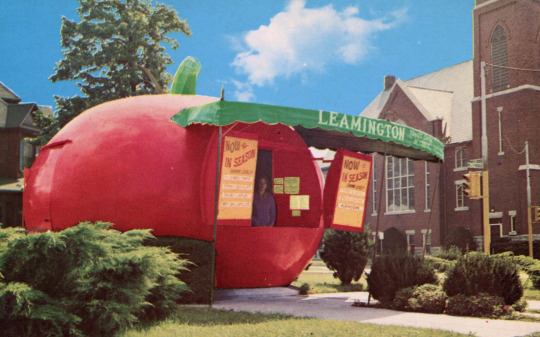
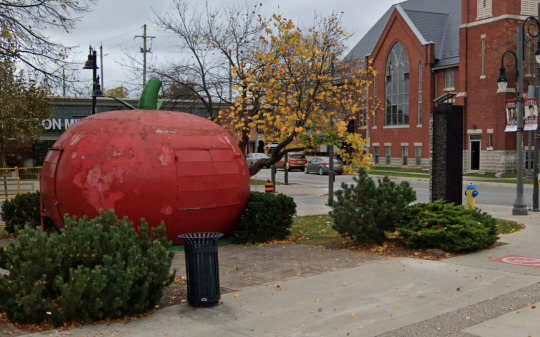

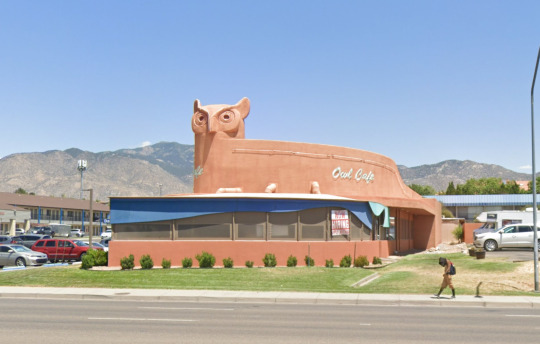
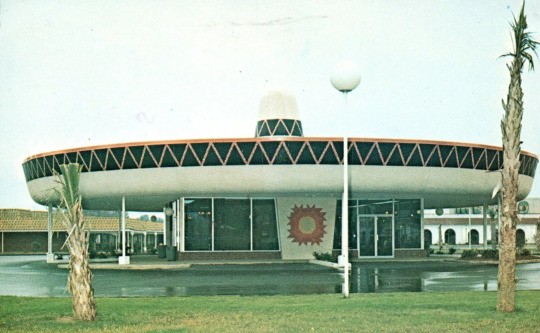



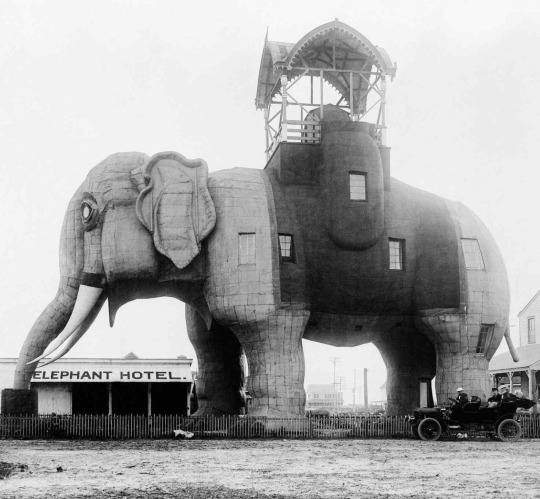
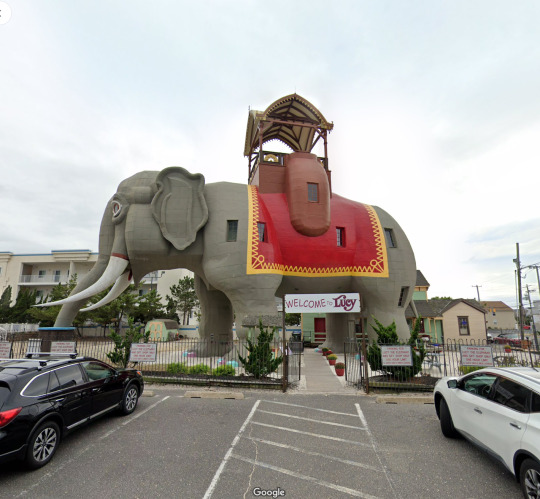

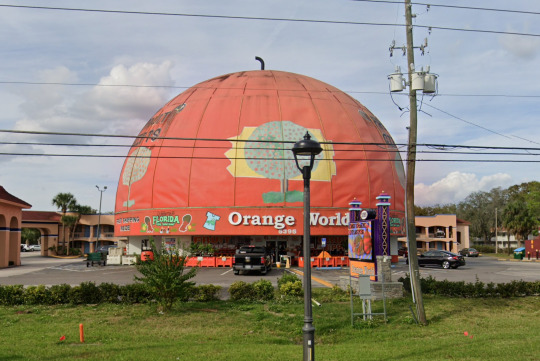


Novelty architecture: a type of building in which structures are designed as familiar shapes such as characters, animals, food, clothing items or household objects. Each one is usually kitschy, gaudy, and eye-catching. This style is also known as ‘mimetic,’ ‘programmatic’ or 'duck' architecture.
Leamington, Ontario's big tomato, circa 1961, is a classic example of this type of building. While it served as a tourist information booth for six decades, water damage and mold forced it to close in 2019. For 5 years, it sat deteriorating. In 2024, the Leamington council approved a restoration project, stating that the tomato is “representation of the area’s rich history and culture." The tomato's days are not over yet.
I've included a few more then + now views of novelty architecture: An owl cafe in New Mexico, a sombrero restaurant in South Carolina, a shoe house in Pennsylvania, an elephant in New Jersey, a big orange in Florida and an airplane-gas-station in Tennessee. Each of these buildings are alive, well and open for business. Most, if not all, have had ongoing restoration efforts and have all been lovingly cared for over the years.
3K notes
·
View notes
Text
3e: Alignment Is Invisible
The entire alignment system is sick from the top to the bottom and racist too.
Content Warning: I’m going to talk smack about not just Dungeons & Dragons‘ morality system in 3rd edition, but also, in the process, talk some smack about Christians, and more specifically the Jehovah’s Witnesses. If you’re not here for that, you should find yourself a door.
Few elements of Dungeons & Dragons that lay bare its deeply incoherent roots have endured quite so long as the alignment system. Whenever discussing the alignment system, and by extension, the conception of morality presented in this game, it’s always worth remembering that the framework was devised by, and speaks to the values of, a deeply racist and misogynistic man who in addition to those larger, more structurally common biases, was also a Jehovah’s Witness and heavily informed by the way that that specific sect of American Christianity works.
I’ll spare you a detailed rundown of what I mean by American Christianity (for now, because this is about Dungeons & Dragons), but instead in the broadest strokes indicate that the alignment system that Gygax conceived of was something cosmically tracked and enforced. It was a truly objective morality system; your intention or your attitude did not matter, because there was an absolute right and an absolute wrong to each action, and characters could choose to comply with that right or not, by degrees.
This is why I say racist: It’s a hard fact in the first editions of D&D under Gygax’s most direct control that killing orc children who hadn’t done anything was a moral good; those creatures were evil creatures, and regardless of consequences killing them was good. Gygax quoted the ‘lice make nits’ line from the colonialism of the Americas to reinforce this position, but he was also quite clear that it was the act itself that had its moral valence, not the results or the intention.
This quite frankly deeply evil and immoral ethical framework was the horse to which Dungeons & Dragons 3rd Edition had to nonetheless hitch its wagon, and the resultant discord show a host of cracks in the way it’s supposed to work. Politicians who starve millions are in no ways doing anything wrong because they’re doing their jobs and there’s nothing evil in signing a piece of paper, but the people who enforce that law and keep orphans away from the food are also not doing anything wrong because they’re just upholding order. The core rulebook of 3rd edition had to try and address this framework without making it too obvious that elements of it were being thrown out the window, especially as the purpose of alignment shifted subtly in the more programmatic, more, let’s say, intentionally designed world of 3rd edition.
See, in 3rd edition, the purpose of alignment was first and foremost to let you target things. Oh sure, it was flavour, it helped to inform some monster behaviours or styles, but mostly, you were never going to scan the alignment of things you fought (not worth the effort) which meant that what alignment did was let you make reasonable guesstimates for smart-targeting of spells and effects. If you threw a spell that protected you from evil creatures into the mix it meant that you had some control over the kinds of threats you’d deal with and then prioritise them. In the purest sense, this was a reference point for magical spells.
Secondarily to that, it informed the moral valence of what you were doing and it was with the rulebooks The Book of Vile Darkness and its prettier but equally vacuous cousin The Book of Exalted Deeds that 3rd edition attempted to really roll up its sleeves and discuss morality in a way that could square the circle of previous editions’ heinous moral landscape and 3rd edition’s attempt to improve it by just rearranging some of the words.
The problem, such as it was, is that alignment was fundamentally invisible. You could have no control over what you did and how it affected you morally, because it was a matter of checking a list of subjects and determining what you did not what you thought or tried to do. If you killed a child and it turns out that child was a shapeshifted demon in disguise, the rules would say that you were in no way morally impacted by your desire to do it. If on the othe hand, you refused to kill the child that was a demon in disguise, because that’s a pretty messed up thing to want to do, then you’d failed to do a good act.
Now, the way the Book of Exalted Deeds tried to grapple with this was by presenting virtues that stood apart from the listed examples of explicitly evil acts. Doing mercy was shown as part of the tension with punishing evil and that’s a pretty good rules patch for the absolutist nature of things. It at least lets the player present something that’s within their control (why they did something) rather than one of those invisible wires around them.
One of the examples the book presented in 3rd edition was that if you climbed a cliff face, and in the process a rock fell and started an avalanche, then that avalanche killed people, then you were morally liable. In fact, a Paladin who did that kind of thing would lose access to their powers, while trying to redeem themselves for the sin of… climbing something.
The added problem with all of this is that no element of opposition or ambition cannot be framed with different moral outlooks that change nothing about how it expresses. A ruthless pursuit of justice and a sadistic love of control over criminals would both be expressed roughly similarly in a Javert-style inspector. A characte’rs own alignment, what they determine their alignment to be is something that can always be rationalised in terms of a framework of moral choices, and those intentions are going to be what informs the actual result of the test. If you’re doing everything right for an asshole reason, the world does not see you as doing evil acts, but your alignment can still be evil because there’s nothing in the world forcing you to change from your mindset of being a total prick.
The 4th edition system did try and push back against this with some interesting ideas of its own, but based on watching people talking about 5th edition games? Boy howdy they did not learn from that and instead decided to RETVRN to the worst version of the system so far.
Check it out on PRESS.exe to see it with images and links!
226 notes
·
View notes
Text
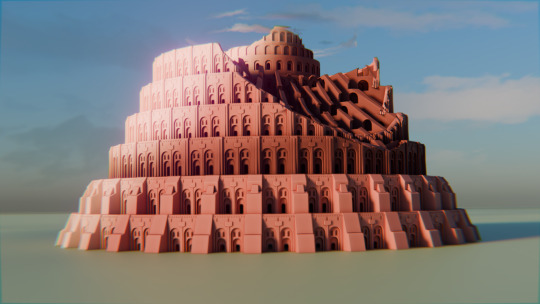

Returning to blender with something comfortable, a new iteration of my neoclassical building generation tool(s). the idea of these tools is to use geonodes to handle the repetitive aspects of the design, usually by designing a single feature (here an arch, and some pillars) and then arranging them programmatically.
the ultimate goal would be something which could quickly make new designs based on changing simple parameters or source features, but for now the node trees need re-tuning for each new design
This building is based on Bruegel's Tower of Babel paintings, possibly the earliest example of dream/fantasy architecture in art
38 notes
·
View notes
Text
I've been thinking about how to have individuals that maximize for uniqueness, and how this is really a very difficult problem.
I've been somewhat idly working on a project I'm calling "72 Waifus", which is probably not going to become anything, but sort of gets at this idea that eventually you run out of ways to differentiate people, and soon two or more people are falling into what is clearly a "cluster". You can try to do things programmatically, by making a bunch of axes and then pushing people as far to the edges of those axes, and have a hypercube where they're at the corners in N-dimensional space or something ... but I think that this is really likely to fail in that it will constrain the project.
Game Maker's Toolkit recently put out a video on how Smash Bros. characters are designed, which was very relevant to my interests here. The roster has more than 80 characters, even if you exclude mechanically identical echo fighters, and there really has been an effort to make sure that there aren't many proper repeats.
But that's for a fighting game, with much different parameters than whatever I'm imagining to be the usecase for 72 waifus.
There's a mange/anime called The 100 Girlfriends Who Really, Really, Really, Really, Really Love You, which people keep mentioning to me as a gimmick I might enjoy, and in a bout of diligence I read the first chapter, which didn't appeal to me. But also, I don't think that anyone has actually said that it's good, so maybe this is on me. (It's comedy, and I keep running into comedies that just seem to exist for the punchline, rather than comedies that are funny because we're taking something ridiculous deathly seriously.)
22 notes
·
View notes
Text

Hoot Owl Cafe, Long Beach, California, 1926
#architecture#hoot owl cafe#owl#Long Beach#california#art#design#photography#black and white#architecture parlante#programmatic architecture#object
115 notes
·
View notes
Text
it seems that when u hang up in a discord voice channel in browser edition (& presumably desktop edition) while keeping said channel focused theres this like. purple glow effect with a waxing/waning animation that shows up against the dark grey background. & it makes my laptop fans spin up pretty loud. discord ui designers were like. you know what this blank space needs? that's right: abstract programmatic animation that eats your cpu
7 notes
·
View notes
Text
ElevateDigi is a full-stack digital marketing agency based in Kolkata, empowering brands with innovative, data-driven strategies that drive real growth. With expertise across SEO, social media marketing (SMM), programmatic advertising, content creation, and graphic design, ElevateDigi delivers end-to-end digital solutions tailored to modern business needs.
Our team combines creativity with performance to help businesses increase visibility, attract qualified leads, and boost conversions. Whether you're a startup or an established brand, ElevateDigi is your strategic partner for building a powerful online presence and scaling digitally.
From optimizing search rankings to creating visually striking campaigns-ElevateDigi helps brands not just grow, but lead.
0 notes
Text

About the world of l𖦹g.OS and some info on the characters which I showed a bit earlier. Perceive these notes as the compilation of concepts for the game that are constantly meticulously brewing in my head since 2023.
bonus: one of the sketches of Bell in her almost current design
MANY-LETTERS-UNDER-THE-CUT-ALERT. I WARNED YOU. MANY!
-----💀-----
THE ANNOTATION
The world of Umbra — the thriving land of dead. Any newcomer is welcomed and can find a place to stay at the Nine Islands. And those who have enough courage may try to take a journey to prove that they're worth of revival in the Land of the Living, known as Beyond.
At least it was like that before Umbra started to fall apart.
Things mix their places. People forget things. Even simple tasks could become not accomplishable. Everything is going out of order... spiraling out of control.
In the middle of all this stays Bell — the only Tuner left in Umbra who tries her best to maintain the ruining land of dead, completely alone. Every time the alarm system in her house — which also is simultaneously the Tuners' base, — rings, signaling about new problems, Bell gets up, takes her tuning fork and goes to find and fix broken things and events in the afterlife world.
Again. And again. And again. And again…
When suddenly the Newcomer appears, which didn't happen in a very long time, Bell goes with them to assist in their journey through the unpredictable, unstable world.
By choosing whom and how to help in Umbra, Bell must find a way to help the Newcomer achieve revival and, as she hopes, to find a way of returning other Tuners back to Umbra.
-----💀-----
SOME REAL MAIN EVENTS AND CONCEPTUAL DETAILS
(idk if i should put spoiler alert here but there's mainly the info that we're suppose to discover during the playthrough; if you're proceeding to read it, then you agree that you won't hit me with a slipper for spoilers)
The world of Umbra is a self-developing next-generation open-world (optionally cooperative) AI game that was supposed to dynamically adjust its world, NPCs and therefore playthrough for each player, but unfortunately it was never released. It accidentally stayed launched on its developer's switched-on computer when the humanity was destroyed in the nuclear war.
Umbra's inhabitants consist of many autonomous free-will (i.e. sentient) NPCs that can still be originally designed to do some specific work (as Manolo and Norah), and Tuners — programmatic operators of main game functions. Only Tuners had access to the information about the real situation of artificial origins of their world and the fact that they're presumably the only intelligent, though digital, species that survived.
There were only four Tuners: Gai, or Gai de Vire (Generative Artificial Intelligence DEveloping VIrtual REality), Lan, or Lanser (LAN Server), Quil (Quest-Inventing Loop) and Bell (Bug-Eliminating Level Launcher).
After discovering the truth about humanity and understanding the fragility of their universe, i.e. computer, and its dependence on the electricity, Tuners found a way to hack and connect to the hydroelectric power station's control center through the net. But since the game and its AI wasn't designed for such a difficult task, and writing commands to the control center required all their efforts, Tuners involved all NPCs in this process by re-adjusting Umbra's original reward system into Tasks to Time and Time to Goods (TTG) exchange system. That means, in reality each in-game Task represents (and masks) a part of the command for the hydroelectric power station's control center. Each NPC that completes an in-game task (quest), gains Time as a reward, in reality putting a necessary brick to writing code for commands for the control center.
Time in the afterlife is both the vital source of life and the main currency that Umbra's inhabitants can "spend" on various Goods from the land of the living, including food that is considered as "conservated Time".
The more calavera markings a person has on their sugar skeleton and the more they glow, the more Time they have at their disposal. The last thing that extinguishes is the person's eyes. If one runs completely out of Time and their eyes extinguish, nothing can bring them back to life (or rather afterlife). From the AI's perspective those NPCs that can't spend and save Time rationally are perceived as useless and therefore should be eliminated or replaced.
Originally, for a player, Umbra offered a journey through the afterlife world to explore it, accomplish various quests and find a way to "revive", therefore after the nuclear war the game in the absence of players became not passable.
By the time when the Newcomer suddenly visits Umbra, this digital world is in such a state that they can neither morph into a sugar skeleton form, appearing as a simple floating ball of light, nor complete the journey alone. Bell, led by curiosity, goes on a journey with them as a support to help them complete the game (that explains why technically we play for Bell — the Newcomer is unable to do anything on their own and Bell simply implements their will).
Bell fears that if the game will be completed, Umbra will shut down. That's why in the end you can either let the Newcomer finish the game or make them stay in Umbra, looping their journey and making them re-pass the game again and again.
The main travelling method between Umbra's locations and especially its Islands is the laundromat navigation system (LNS or how people call it, LaNS). Umbra inhabitants travel through LaNS literally inserting a coin, getting into the laundry machine and washing themselves away, appearing in another laundry machine in the location they chose beforehand. I got this idea when I heard the phrase about cleansing our souls. I snorted and imagined a washing machine that washes a dirty soul like a t-shirt. That's it. I kept this concept, both because it's funny and has a strong bond with the spiral theme of l𖦹g.OS.
In the current events of l𖦹g.OS LaNS is unstable, i.e. broken, and, despite citizens' discontent, Bell keeps to find excuses to not repair it (though, technically, at least that she can do). She does that because Lanser gave her a promise to repair it himself before he disappeared. Bell has a deep inner fear that if she repairs LaNS, Lanser won't come back, because he'll lose the only unfinished task that still connects him to Umbra. Nowadays Bell is the only one who can rather safely travel around Umbra and help everyone accomplish their Tasks to gain Time.
While the characters in my idea are going to be "voiced" by various musical instruments, the soundtrack in l𖦹g.OS will consist from the street and furniture noises, i.e. simple harmonized noises of the everyday life. The more bugged the recent location is, the more these noises will turn from a consonant melody into cacophony. When Bell fixes things, the melody goes back to tuned.
-----💀-----
About the characters I showed, in order of appearance in the story (ofc there are more, but I prefer to tell about ones I already drew :3)
Bell (Bug-Eliminating Level Launcher) is the main character and the only Tuner left in Umbra, who tries her best to maintain the ruining land of dead alone and find the way to contact with the missing Tuners. Though her belief in their return is strong, day by day it wilts with the dying world. She has no access to their operational functions in the system, therefore she does the only thing that she can and for which she was designed: non-stopably eliminates the ever multiplying errors and bugs. The thing that turned into a completely Sisyphean task. Bell is extremely tired, but still hopes that in the end everything will be fine. Voice: obviously, Bell speaks in sounds of bells, the timbre and the pitch range of which depends on her mood.
Norah is the psychopomp of Umbra who helps the newcomers to morph into a sugar skeleton and delivers them to the shores of the First Island. She's also the fiancée of Gai de Vire and the only person who dares to accomplish Tasks that appear in the Sea of Memories. Norah believed she died from an incurable disease. In secret, Norah knows what Tuners know, because Gai told her this way before he left, but she hid her jaw not to tell it to the others and pretends she's oblivious. Voice: none now, because she lost her jaw and therefore ability to talk, but previously Norah spoke in sounds of lyre. Fun fact: despite Bell was the first character from which the story started in my head, Norah was the one who brought the major strokes to the world of Umbra with herself. Her core inspirations: Charon, Lenore and Eleonora, have a rich intertwining with the afterlife concepts and therefore established many main aspects of the worldbuilding. Aside of that, there are some references to Poe's pieces here and there (which I won't mention, leaving it to your future discover), because I adored his literary works in my youth; forgive me that much. x))
Manolo is the only kid in Umbra — energetic, eager to communicate and learn, always making the days brighter with his upbeat attitude. It's believed that children's souls go straight to reincarnation, yet Manolo, for some reason, became an exception of this rule. No one, except the Tuners, knows of his cruel fate. He is designed to be a friendly companion NPC that eagerly shows and explains the newcomers how to do this or that. Unlike Norah, who just welcomes and delivers the newcomers to the shore, Manolo is a huge lore keeper and enthusiastic support at the first steps of every newcomer. He doesn't remember how he died, that's why believes he died in his sleep. He can be met in the village on the First Island and usually can be found on the streets, at Beata's treehouse or sticking around Bell, to whom he always wants to help. Voice: melodica.
Beata is a nice old lady with obsession on plants. She can knit you whatever you want. She lives on the First Island in a treehouse. Once she was a nun, but then someone switched her holy book with Lord of The Rings and she left her church and joined the tolkienists club after reading it. She died at the very old age from drinking bleach instead of milk. She has many stories to tell, that's why Manolo usually sticks around her. Many of those stories, usually told in a cheerful manner, are anecdotes about how people she knew personally or heard about died in very dumb ways. Voice: harmonica.
Bono, or Boniface was once a qualified veterinarian, who died on a punk concert, because someone bashed his skull with a bottle of beer — that's why his skull has a star-shaped hole in it. Bono is a very eager music lover who spends his Time on the music instruments and vinyl records from Beyond, sugar cigarettes (please tell me you also remember those from the times when you were kids 😭) and treats for Gunter. If Bell calls him Bony-face, he calls her Eggface in return because of her head shape, but it's nothing but a friendly banter. Voice: electric guitar.
Gunter is presumably a cat — Bono secretly reassembled him like a children's building kit from the various animal bones he dug out somewhere in Umbra ("at last someone found unused assets haha", thinks the dead game developer) and made him paper ears so he at least would look like something distantly cat-ish. How he brought him to life is unknown, because it's the common knowledge that once you're dead in Umbra, nothing can bring you back. So Gunter can be very much a glitch/anomaly. Voice: Thanks to our real cat Sonya, Gunter sounds like theremin, because our cat's meows made me used to calling her theremincat (кошка-терменвошка или просто терменкошка).
-----💀-----
I haven't drawn them yet, because, well, in my idea they won't visibly appear in-game rather than in talks (i.e. others' memories) until the very end, if ever appear at all, but they deserve to be mentioned in the first post, too. Other three lost Tuners:
Gai, or Gai de Vire (Generative Artificial Intelligence DEveloping VIrtual REality). The first Tuner — the runaway captain of this drowning digital ship. Maintained the stability of the main operational system, keeping the consonance of the system's parts and coordinating the self-recreating computation model and developing processes. He came to the conclusion that their world is artificially limited in development and their surviving method is only a half-measure, and he can't find a more efficient solution for their problem with current recourses they possess. That's why he tricked Lan into letting him go through the Gate to the Main Network to find (or build) a more sustainable, durable base for further development. Voice: contrabass clarinet.
Lan, or Lanser (LAN Server). The Tuner who established and maintained Umbra's travelling mechanisms and maintained stable net connection with Beyond. Though being an artificial being, he was mesmerized by the human world and their scientific development and dreamed of building a path to Beyond to see it with his own eyes. But, unlike Gai, Lan was against abandoning Umbra and under the pressure of guilt after revealing Gai's real intentions he left to pursue and bring Gai back to Umbra, since Gai was the only one who had access to the main operational system. Voice: bass trombone. I understand how awfully ridiculous it sounds that Lanser created LaNS, but I can't not find this definitely-not-intentional-coinsidence-in-names endearing in the context of his character depiction.
Quil (Quest-Inventing Loop). The Tuner who maintained the stability of plotline development and configured the judging systems of tasks accomplishment and fair exchange of Tasks to Time and Time to Goods. He was the one who suggested how to transform in-game quests into commands for the hydroelectric power station's control center. When Gai left, he went with Lan to help him bring Gai back. Voice: tambourine.
#heldig arts#heldig writings#l𖦹g.OS#point and click game concept#lore dump#infodump#original project#original characters#original character#original art#original concept#original content
13 notes
·
View notes
Text
I am looking for ways to switch from having an idea to doing everything in order to fulfill the goal of the idea.
When the idea is from others, hey man, no problem.
But my own ideas?
Wrote down a few lines about this in my morning pages, which are not morning pages at all, and added a footnote there, on page 94:
“ideas travel in groups, or do they multiply by budding?”
I wrote down two ideas, too, which are my goals:
I want to draw figuratevily/create fine art
I want to design computationally/programmatically
I want…
For now, I think that having an idea is about as good as it gets. Spending more time in your own head, thinking about this idea without an action, an execution?
Now that’s just failing to start.
I have just familiarised myself with rock bottom and assured myself of it being solid ground to stand and build upon.
Fingers crossed that writing about this is not thinking about ideas in another medium, huh?
8 notes
·
View notes
Text





THE BIGGEST BITE IN THE MONSTROUS BURGER HISTORY OF CLASSIC, VINTAGE LOS ANGELES.
PIC(S) INFO: Mega spotlight on “The Burger That Ate L.A," a now legendary and world famous burger joint on Melrose Ave. in the shape of a giant cheeseburger. "This amazing attempt at wackiness was designed by Solberg and Lowe Architects and created by owner David Alderman. "
MINI-OVERVIEW: "We all know that programmatic architecture in Los Angeles was very popular in the 1920s and 1930s, but here’s an example of a programmatic structure, during the 1980s and 1990s… The Burger That Ate L.A. was a latecomer in Los Angeles' venerable pantheon of fantasy architecture. It ranked up there with Randy's Donuts and Tail o' the Pup.
The Burger That Ate L.A. held its own on trendy Melrose Ave. The bun-shaped dome once devoured the corner of Stanley Avenue. The unconventional facade (with sesame seeds) was shaped like a giant cheeseburger had glass bricks forming as ketchup and oozing with onions. The structure also appeared to have a missing bite chomping on City Hall."
-- ALISON MARTINO'S "Vintage Los Angeles," "The Burger That Ate L.A.," published June 15, 2024
Source: http://martinostimemachine.blogspot.com/2024/06/the-burger-that-ate-la.html.
#The Burger That Ate L.A.#Vintage Los Angeles#Vintage L.A.#Vintage Style#L.A. Style#L.A.#Los Angeles#Burger Joint#Vintage Restaurants#Giant Cheeseburger#80s L.A.#Melrose Ave#American Style#Melrose Avenue#Retro L.A.#1980s#80s#Giant Cheeseburger Architecture#Cheeseburgers#American Diners#80s Style#L.A. Architecture#Americana#Burger Joints#Wacky Architecture#Burgers#Vintage Menu#Hamburgers#Los Angeles CA#Vintage Menus
5 notes
·
View notes